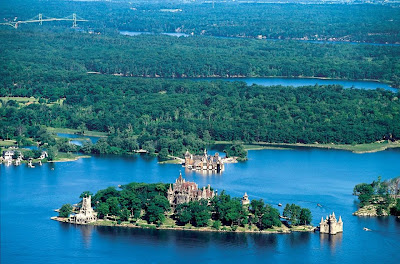Boldt Castle~A Castle Built For Love
This is an aerial view of Boldt Castle and some of the Thousand Islands in the Saint Lawrence River, near Alexandria Bay, New York. George Boldt had this five-acre castle estate built out of love for his wife. He planned to give his wife Bo
ldt Castle on Valentine’s Day 1905. As you will see in many of these castles built for love, there is a reoccurring theme of tragedy striking at the heart of love.
Boldt Castle is not a real castle, of course, but a fairy tale version of one. It's a jigsaw puzzle of medieval and Victorian styles pieced together by the firm of W.D. Hewitt and G.W. Hewitt - the same architects who designed the fanciful Druim Moir castle in Philadelphia.
Like many homes from America's Gilded Age, the eleven-building complex is exuberant and outrageous, as though its creators had taken five hundred years of architectural history and spilled it across the craggy island.
Legend has it that multi-millionaire George Boldt ordered the castle built as a testimonial of his love for his wife, Louise. She was only fifteen when they married, and she had worked at his side during his climb to wealth and prominence. Boldt planned to present the castle to Louise on Valentine's Day, 1905.
A Castle Built For Love
Of all the grand summer homes in the Thousand Islands, Boldt Castle was to be the most magnificent. More than 300 artisans, masons, stonecutters, landscapers, and other craftsmen were hired. The Alster Tower would be a gigantic playhouse with a bolling alley, a billiard room, a library, bedrooms, and kitchen areas.
The Power House would hold a steam-powered generator for power and lights. The Yacht House would shelter the family houseboat and boats from visitors. But the crowning jewel would be a 120-room home modeled after a Rhineland castle and furnished with paintings, sculptures, mosaics, and tapestries from around the world.
This grand design was never completed, however. Construction halted when a sudden tragedy struck the young family.
Tragedy at Boldt Castle
One year before Boldt Castle was to be completed, Louise, aged 41, died. Brokenhearted, George Boldt stopped the construction and never returned to the island. Boldt died in 1916 and the castle was purchased by Edward John Noble, who owned the Beechnut Fruit Company. Noble invested in the area and built the Thousand Island Club. Over the next 50 years, the E.J. Noble Foundation ran Boldt Castle as a tourist attraction.
Visitors were allowed to roam the island freely, and the castle became a victim of vandals who broke windows, covered walls with graffiti, and stripped buildings of ornamental details. Roofs leaked, timbers deteriorated, plaster peeled from walls. A fire destroyed all but the stone shell of the Powerhouse.
Boldt Castle is not a real castle, of course, but a fairy tale version of one. It's a jigsaw puzzle of medieval and Victorian styles pieced together by the firm of W.D. Hewitt and G.W. Hewitt - the same architects who designed the fanciful Druim Moir castle in Philadelphia.
Like many homes from America's Gilded Age, the eleven-building complex is exuberant and outrageous, as though its creators had taken five hundred years of architectural history and spilled it across the craggy island.
Legend has it that multi-millionaire George Boldt ordered the castle built as a testimonial of his love for his wife, Louise. She was only fifteen when they married, and she had worked at his side during his climb to wealth and prominence. Boldt planned to present the castle to Louise on Valentine's Day, 1905.
A Castle Built For Love
Of all the grand summer homes in the Thousand Islands, Boldt Castle was to be the most magnificent. More than 300 artisans, masons, stonecutters, landscapers, and other craftsmen were hired. The Alster Tower would be a gigantic playhouse with a bolling alley, a billiard room, a library, bedrooms, and kitchen areas.
The Power House would hold a steam-powered generator for power and lights. The Yacht House would shelter the family houseboat and boats from visitors. But the crowning jewel would be a 120-room home modeled after a Rhineland castle and furnished with paintings, sculptures, mosaics, and tapestries from around the world.
This grand design was never completed, however. Construction halted when a sudden tragedy struck the young family.
Tragedy at Boldt Castle
One year before Boldt Castle was to be completed, Louise, aged 41, died. Brokenhearted, George Boldt stopped the construction and never returned to the island. Boldt died in 1916 and the castle was purchased by Edward John Noble, who owned the Beechnut Fruit Company. Noble invested in the area and built the Thousand Island Club. Over the next 50 years, the E.J. Noble Foundation ran Boldt Castle as a tourist attraction.
Visitors were allowed to roam the island freely, and the castle became a victim of vandals who broke windows, covered walls with graffiti, and stripped buildings of ornamental details. Roofs leaked, timbers deteriorated, plaster peeled from walls. A fire destroyed all but the stone shell of the Powerhouse.




.jpg)

.jpg)


0 comments:
Post a Comment